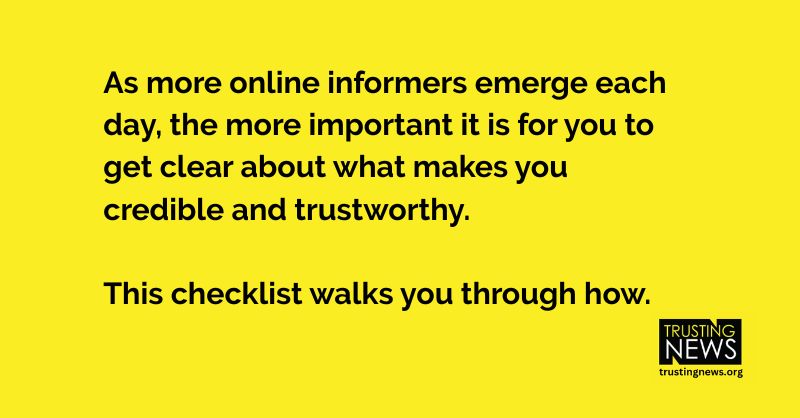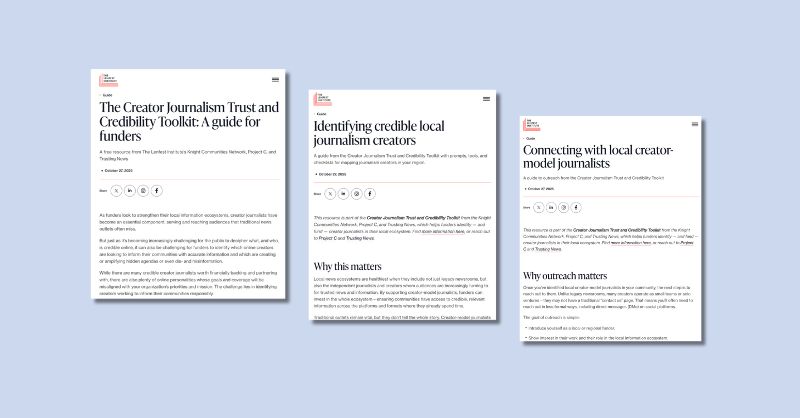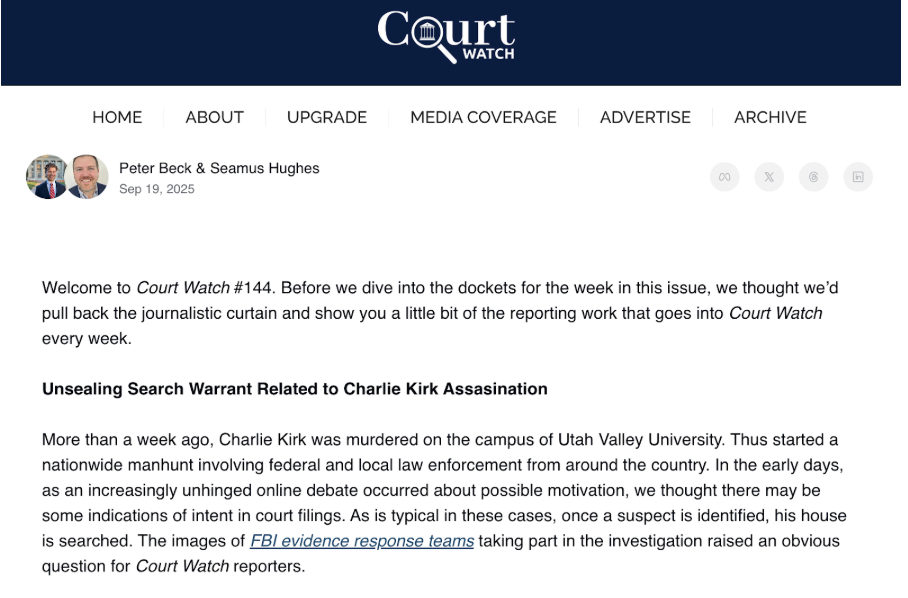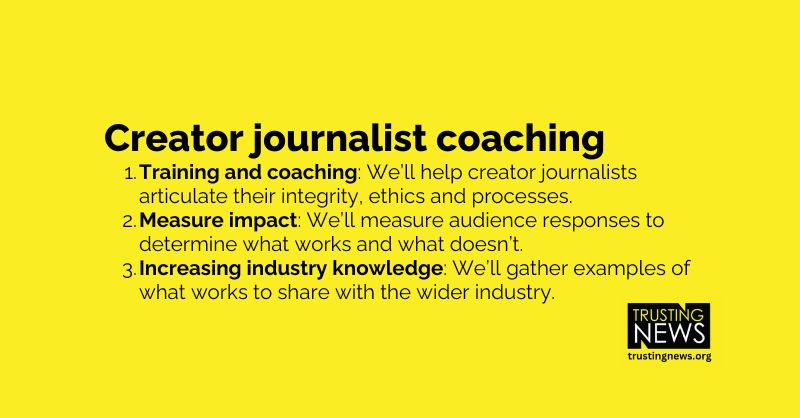
This new Toolkit covers tactical ways for funders to find credible creator journalists in their region
Show you’re trustworthy: An ethics checklist for creator journalists
Credible creator journalists are an important part of local information ecosystems, filling coverage gaps and serving audiences who often don’t tune into traditional news coverage.
However, more influencers, creators and news sources emerge online each day — and not all of these informers have the goal of sharing responsible, accurate information with their communities. This is making it harder and harder for people to decipher if what they’re seeing online is actually true.
That’s why it’s crucial for credible creator journalists to not only prioritize sharing news in a responsible, ethical way, but also get clear about what makes them trustworthy.
We know there’s a strong desire for guidance around this. In a survey done by Project C and Trusting News, 86% of journalists surveyed agreed there should be a shared set of ethical standards for independent creator journalists. Plus, a UNESCO report published in late 2024 found that 63% of influencers “lack rigorous fact-checking protocols, despite their significant impact on public discourse.”
We created this checklist to help. It’s designed to walk creator journalists through the core ethics of journalism and how to get clear about those ethics with their audience. Not only will this help your bottom line by deepening trust and loyalty with your audience, but it will also help make it easier for people to find and access credible news.
Note: This checklist is part of the Creator Journalism Trust and Credibility Toolkit, created by The Lenfest Institute, Trusting News and Project C. where you’ll find a version of this checklist to help funders identify local creators in their communities.
Checklist for signaling credibility and trust
Are you trustworthy and fair?
Cite your sources. Whether you aggregate content from other news websites or do your own reporting, get clear about where you’re sourcing information. If aggregating, be sure to always name the outlet and reporter. When the platform allows, link back to the original reporting. If you’re doing your own reporting, link to any original documentation.
- Example: Sophia Smith Galer includes screenshots of the sources where she gets information in her video and includes a list in the caption as well.
- Resource: This resource walks you through how to get transparent about your sourcing,
Use credible sources (and explain that). Whether you aggregate information or do first-hand reporting, make sure you are drawing information from reputable institutions, experts and well-documented evidence. Source information from multiple sources and institutions rather than relying on single anecdotes or sources. And when you can, explain why you picked those sources — why their voice or expertise was needed, what makes them an expert in this topic.
- Example: In a video about their guiding principles, Joss Fong and Adam Cole of Howtown explain their use of primary sources.
- Resource: This resource walks you through how to get transparent about your sourcing,
Talk about what’s opinion. Creators’ personality-driven content and clear point of view are often reasons why people turn to them as trusted informers. While you may share their point of view or experiences more than a traditional journalist would, it can become ethically murky if you share opinions (of your own or others) but present those opinions as fact. Anytime you share an opinion, be sure to label or frame it as such. Make it clear that you are sharing your personal beliefs.
- Example: Tangle News always includes “My Take” at the end of their newsletters for readers to understand the thought process behind the people who are delivering the news.
- Resource: This resource walks you through how to label your opinion content.
Show how you work to be fair. News consumers often say they want content that feels fair and balanced. Even if your product includes analysis, you should strive to be accurate and not slant the facts of a story based on your own point of view. Some signals of fairness: Ensure multiple sources or viewpoints are represented; don’t use labels to oversimplify or stereotype an entire group of people or their beliefs; don’t portray partial information as the whole story in ways that might misrepresent the truth for some people.
- Example: Marques Brownlee shared a video addressing whether bad reviews killed companies, and how he works to be honest with reviews.
- Resource: Here’s a look at how the San Diego Union-Tribune articulates what “fairness” means to them in practice. Try making your own version.
Acknowledge uncertainty. It feels good to have answers, but leaving room for uncertainty can actually help show you’re commitment to getting things right — not just first. Instead of rushing to answers, be upfront about what is unknown or why it’s still unknown. Leave space, and when appropriate, ask your audience for input or help.
- Example: Dr. Katelyn Jetelina’s Your Local Epidemiologist newsletter regularly acknowledges uncertainty when covering public health updates.
- Resource: Here are some ways you can address uncertainty during breaking news situations.
Are you accountable and transparent?
Be clear about your goals. Not every online creator has the goal of informing and serving their communities, nor does every online creator care about being seen as a trusted, ethical source. However, if you’re a creator who DOES care about sharing credible information with your audience, let them know! Do you explain complex topics in an easy-to-understand way? Do you cover a niche no one else is covering? Talk about that with your audience. Or to level up, write a mission statement and include it routinely in your content and linked from your bio.
- Example: Here’s an example of a strong mission statement from Matt Kiser, who writes the newsletter WTF Just Happened Today.
- Resource: This resource walks you through how to write a mission statement.
Publicly correct errors. Mistakes happen, but publicly acknowledging and correcting them is a good way to set yourself apart from unreliable or sketchy sources. The next time you have to update information or correct a mistake, talk about it with your audience. Share why the mistake happened, how you corrected it and how you’ll work to prevent it in the future. You may even consider creating best practices or a policy around how you’ll handle mistakes.
- Example: Isaac Saul, who runs the Tangle News newsletter, not only puts corrections at the top of the newsletter, but numbers them, too.
- Resource: Here’s a step-by-step guide for how to handle corrections.
Get transparent about funding. People are skeptical about whether the online content they’re seeing is authentic or a marketing ploy. While many creators rely on advertisements and sponsorships to stay in business, credible creators should get clear about these funding sources and share any potential conflicts of interest. On a very basic level, this looks like you disclosing any ads, gifts or sponsorships. But you can level up and share more details about how you’re funded and maintain editorial independence. This could look like sharing your revenue breakdown; talking about how you do (or don’t) accept gifts or trips; what standards you consider when accepting brand deals.
- Example: In this video, Becca Farsace explains the ethics behind her work, including how she labels sponsored content and her ethics behind accepting money from brands.
- Resource: Here’s a guide for how journalists can get transparent about money, ads and ownership.
Talk about who you are. Inviting people to learn about your background and experience is a good way to establish trust and show credibility. This is especially true for creator journalists, since creators aren’t required to go through any formal vetting process before starting. You might not have a background in journalism — that’s OK! You can still share information that invites people to get to know you and identify you as a credible source. This may look like: An identifiable byline; a bio that shares relevant experience; relevant information about your background or perspective; why you got interested in this topic and got started; ways to get in touch and share feedback; any information about your mission and ethics.
- Example: Bianca Graulau used the Get Ready With Me trend to tell her story of how she got into independent journalism.
- Resource: This step-by-step guide walks you through how to talk about who you are as a journalist.
Explain how you gather information. Most people don’t understand how the news works, making them skeptical of journalists’ motives and more susceptible to believing unreliable information. You can help counter this by explaining your process and getting clear about your reporting process. This could look like explaining why you’re covering a certain story, how you decide what to cover, where you get story ideas, what questions you’re setting out to answer, etc.
- Example: Seamus Hughes, one of the creators behind Court Watch, wrote a newsletter explaining how they worked to unseal a federal search warrant.
- Resource: Find more examples and strategies for how you can get transparent in your daily content here.
Are you community focused?
Engage with your audience. Engagement not only helps you build relationships and loyalty with your audience, but also helps ensure your content is focused on the people it aims to serve. This relationship-building can look all sorts of ways, like responding to comments (even negative ones); asking people for questions and feedback; bringing users into the reporting process; or even hosting conversations or events with audience members.
- Example: After the 2024 election, Jessica Yellin of News Not Noise centered her audience’s questions in her reporting and hosted a Zoom conversation to “find community, process the results and understand what happens next.”
- Resource: This resource walks through ways to stay in conversation with your audience.
Work to minimize harm. Informers have a challenging responsibility of balancing the public’s need to know while minimizing any potential harm that publishing information may cause. Be mindful of not getting caught up in trying to publish the biggest scoop — instead, center what will be most helpful to your community. And whenever you DO have to make tough calls about whether to publish or not publish certain content, explain those decisions to your audience.
- Example: Here’s how USA TODAY explained a tough decision to publish the powerful photo of a father and daughter who drowned at the border.
- Resource: Here’s guidance on how you can be thoughtful about covering traumatic events.
Show you’re working on behalf of the community. At its core, journalism is a public service. If your goal is to inform and strengthen your community, make that clear. Prioritize providing information that is helpful and relatable — and not just always covering the latest big story or viral moment.
- Example: The introductory email for the Torched newsletter, by Alissa Walker, shares how she’ll work to find solutions alongside the community.
- Resource: Here’s a look at how you can ask your community what coverage would be most useful.
Be mindful of diverse reporting. Communities deserve access to information that not only meets their information needs but also reflects their own lived experience. Even if you serve a niche audience, be mindful of considering multiple perspectives in your content. You could do this by including sources with different backgrounds and lived experiences in your content, or by simply acknowledging that not everyone has the same experience or that others might view things differently.
- Example: Filmmaker Dean Bog produced a neighborhood series about Pittsburgh where he interviewed dozens of people from each neighborhood, letting them share their own stories and experiences.
- Resource: It can be helpful to take stock of how you see the world and consider what perspectives you might be missing. Here are some exercises to help you do that.
At Trusting News, we learn how people decide what news to trust and turn that knowledge into actionable strategies for journalists. We train and empower journalists to take responsibility for demonstrating credibility and actively earning trust through transparency and engagement. Learn more about our work, vision and team. Subscribe to our Trust Tips newsletter. Follow us on Twitter, BlueSky and LinkedIn.

Project manager Mollie Muchna (she/her) has spent the last 10 years working in audience and engagement journalism in local newsrooms across the Southwest. She lives in Tucson, Arizona, where she is also an adjunct professor at the University of Arizona’s School of Journalism. She can be reached at mollie@trustingnews.org and on Twitter @molliemuchna.


